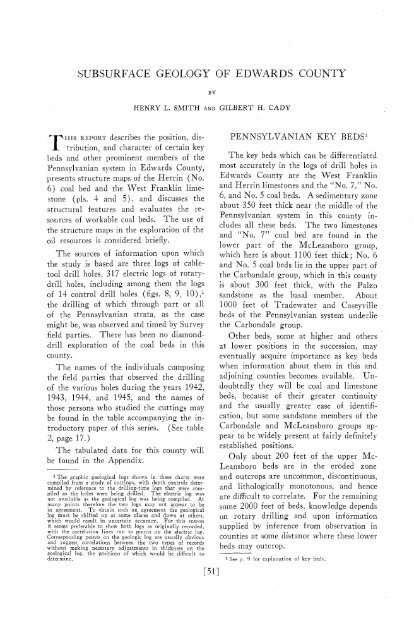subsurface geology and coal resources of the pennsylvanian system ...
subsurface geology and coal resources of the pennsylvanian system ...
subsurface geology and coal resources of the pennsylvanian system ...
Create successful ePaper yourself
Turn your PDF publications into a flip-book with our unique Google optimized e-Paper software.
SUBSURFACE GEOLOGY OF EDWARDS COUNTY<br />
BY<br />
HENRY L. SMITH AND GILBERT H. CADY<br />
1x1s REPORT describes <strong>the</strong> position, distribution,<br />
<strong>and</strong> character <strong>of</strong> certain key<br />
beds <strong>and</strong> o<strong>the</strong>r prominent members <strong>of</strong> <strong>the</strong><br />
Pennsylvanian <strong>system</strong> in Edwards County,<br />
presents structure maps <strong>of</strong> <strong>the</strong> Herrin (No.<br />
6) <strong>coal</strong> bed <strong>and</strong> <strong>the</strong> West Franklin limestone<br />
(pls. 4 <strong>and</strong> 5), <strong>and</strong> discusses <strong>the</strong><br />
structural features <strong>and</strong> evaluates <strong>the</strong> <strong>resources</strong><br />
<strong>of</strong> workable <strong>coal</strong> beds. The use <strong>of</strong><br />
<strong>the</strong> structure maps in <strong>the</strong> exploration <strong>of</strong> <strong>the</strong><br />
oil <strong>resources</strong> is considered briefly.<br />
The sources <strong>of</strong> information upon which<br />
<strong>the</strong> study is based are three logs <strong>of</strong> cabletool<br />
drill holes, 317 electric logs <strong>of</strong> rotarydrill<br />
holes, including among <strong>the</strong>m <strong>the</strong> logs<br />
<strong>of</strong> 11 control drill holes (figs. 8, 9, 10) ,'<br />
<strong>the</strong> drilling <strong>of</strong> which through part or all<br />
<strong>of</strong> <strong>the</strong> Pennsylvanian strata, as <strong>the</strong> case<br />
might be, was observed <strong>and</strong> timed by Survey<br />
field parties. There has been no diamonddrill<br />
exploration <strong>of</strong> <strong>the</strong> <strong>coal</strong> beds in this<br />
county.<br />
The names <strong>of</strong> <strong>the</strong> individuals composing<br />
<strong>the</strong> field parties that observed <strong>the</strong> drilling<br />
<strong>of</strong> <strong>the</strong> various holes during <strong>the</strong> years 1942,<br />
1913, 1944, <strong>and</strong> 1945, <strong>and</strong> <strong>the</strong> names <strong>of</strong><br />
those persons who studied <strong>the</strong> cuttings may<br />
be found in <strong>the</strong> table accompanying <strong>the</strong> introductory<br />
paper <strong>of</strong> this series. (See table<br />
2, page 17.)<br />
The tabulated data for this county will<br />
be found in <strong>the</strong> Appendix.<br />
The graphic geological logs shown in <strong>the</strong>se charts were<br />
compiled from a study <strong>of</strong> cuttings, with depth controls determined<br />
by reference to <strong>the</strong> drilling-time logs that were compiled<br />
as <strong>the</strong> holes were being drilled. The electric log was<br />
not available as <strong>the</strong> geological log was being compiled. At<br />
many points <strong>the</strong>refore <strong>the</strong> two logs may not appear to be<br />
in agreement. To obtain such an agreement <strong>the</strong> geological<br />
log must be shifted up at some places <strong>and</strong> down at o<strong>the</strong>rs,<br />
which would result in uncertain accuracy. For this reaqon<br />
it seems preferable to show both logs as originally recorded,<br />
with <strong>the</strong> correlation lines run to points on <strong>the</strong> electric log.<br />
Corresponding points on <strong>the</strong> geologic log are usually obvious<br />
<strong>and</strong> suggest correlations between <strong>the</strong> two types <strong>of</strong> records<br />
without making necessary adjustments in thickness on <strong>the</strong><br />
geological log, <strong>the</strong> positions <strong>of</strong> which would be difficult to<br />
deterrn~ne.<br />
PENNSYLVANIAN KEY BEL)S2<br />
The key beds which can be differentiated<br />
most accurately in <strong>the</strong> logs <strong>of</strong> drill holes in<br />
Edwards County are <strong>the</strong> West Franklin<br />
<strong>and</strong> Herrin limestones <strong>and</strong> <strong>the</strong> "No. 7," No.<br />
6, <strong>and</strong> No. 5 <strong>coal</strong> beds. A sedimentary zone<br />
about 350 feet thick near <strong>the</strong> middle <strong>of</strong> <strong>the</strong><br />
Pennsylvanian <strong>system</strong> in this county includes<br />
all <strong>the</strong>se beds. The two limestones<br />
<strong>and</strong> "No. 7" <strong>coal</strong> bed are found in <strong>the</strong><br />
lower part <strong>of</strong> <strong>the</strong> McLeansboro group,<br />
which here is about 1100 feet thick ; No. 6<br />
<strong>and</strong> No. 5 <strong>coal</strong> beds lie in <strong>the</strong> upper part <strong>of</strong><br />
<strong>the</strong> Carbondale group, which in this county<br />
is about 300 feet thick, with <strong>the</strong> Palzo<br />
s<strong>and</strong>stone as <strong>the</strong> basal member. About<br />
1000 feet <strong>of</strong> Tradewater <strong>and</strong> Caseyville<br />
beds <strong>of</strong> <strong>the</strong> Pennsylvanian <strong>system</strong> underlie<br />
<strong>the</strong> Carbondale group.<br />
O<strong>the</strong>r beds, some at higher <strong>and</strong> o<strong>the</strong>rs<br />
at lower ~ositions in <strong>the</strong> succession, may<br />
eventually acquire importance as key beds<br />
when information about <strong>the</strong>m in this <strong>and</strong><br />
adjoining counties becomes available. Undoubtedly<br />
<strong>the</strong>y will be <strong>coal</strong> <strong>and</strong> limestone<br />
beds, because <strong>of</strong> <strong>the</strong>ir greater continuity<br />
<strong>and</strong> <strong>the</strong> usually greater ease <strong>of</strong> identification,<br />
but some s<strong>and</strong>stone members <strong>of</strong> <strong>the</strong><br />
Carbondale <strong>and</strong> McLeansboro groups appear<br />
to be widely present at fairly definitely<br />
established positions.<br />
Only about 200 feet <strong>of</strong> <strong>the</strong> upper Mc-<br />
Leansboro beds are in <strong>the</strong> eroded zone<br />
<strong>and</strong> outcrops are uncommon, discontinuous,<br />
<strong>and</strong> lithologically monotonous, <strong>and</strong> hence<br />
are difficult to correlate. For <strong>the</strong> remaining<br />
some 2000 feet <strong>of</strong> beds, knowledge depends<br />
on rotary drilling <strong>and</strong> upon information<br />
supplied by inference from observation in<br />
counties at some distance where <strong>the</strong>se lower<br />
beds may outcrop.<br />
See p. 9 for explanation <strong>of</strong> key beds,
















